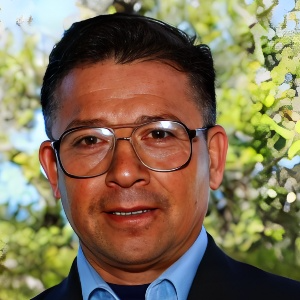Edgar Omar Rueda Puente, Universidad de Sonora, Mexico
Food production in the world is one of the greatest challenges to achieve various purposes, among which is the supply of foods of plant origin, under the principle of sustainability, health, quality and agri-food safety. In the agri-food field, the main agent is the Agricultural [....] » Read More




Title : Isolation and functional properties of biomolecules of plants and its application
Balagopalan Unni, GEMS Arts & Science College (Autonomous), India
The biodiversity of the North-East is very rich with 50% of the country’s flora and fauna and includes wild relatives of 132 identified and economically important species besides a large number of primitive plants and animals. Large number of biologically important molecule [....] » Read More
Title : Integrated approach to the exploration, collection characterization, and conservation of RET medicinal plants in India
P E Rajasekharan, ICAR-IIHR, India
Will be Updated Soon...
Title : Exploring the genetic diversity in tannin-rich forages to explain the large intra species variability in tannin content
Selina Sterup Moore, Aarhus University, Denmark
Tannin-rich forages hold great potential in improving the environmental impact of ruminant production systems as they can reduce methane emissions by inhibiting enteric fermentation while simultaneously enhancing soil carbon sequestration by slowing decomposition and lowering eco [....] » Read More
Title : Primed for the future: PGPR and the promise of sustainable, heritable crop resilience
Prashant Singh, Banaras Hindu University (BHU), India
Achieving Sustainable Development Goal (SDG) 2: Zero Hunger requires innovative strategies to ensure stable crop yields in the face of mounting global challenges. Developing disease-resistant crops offers a sustainable alternative to chemical pesticides, which often harm the envi [....] » Read More
Title : Revealing allelic variations in candidate genes associated with grain yield under salinity stress between two contrasting rice genotypes
Nisha Sulari Kottearachchi, Wayamba University of Sri Lanka, Sri Lanka
With the aim of assisting the breeding of salinity tolerant rice varieties by incorporating tolerance-associated candidate genes with desirable alleles, we previously re-sequenced the whole genome of two varieties, At354 (salinity tolerant) and Bg352 (salinity susceptible), using [....] » Read More
Title : Adaptive strategies of Aristida L. species across ecological zones of Pakistan: Linking soil characteristics with morphological and physiological traits
Iram Ijaz, University of Agriculture Faisalabad Pakistan, Pakistan
In Pakistan, the grass genus Aristida (Family Poaceae) is studied for its physiological traits, ecological distribution, and adaptive strategies across diverse environments. This study investigates four species—Aristida adscensionis, A. cyanantha, A. funiculata, and A. muta [....] » Read More
Title : Ethnobotanical survey and abundance of weeds in selected Manihot esculenta (cassava) Crantz farms in Osun state, Nigeria
Dada Caleb Mayokun, University of Ibadan, Nigeria
This study identified and classified weed species found in selected cassava farms in Osun State. It also surveyed and documented the ethnobotanical importance of weeds found in the farms and determined the abundance of weeds in the study area. These were with the view to providin [....] » Read More
Title : Morphorgenic effect of UV-light on two Abelmoschus esculentus (L.) Moench.(Okra) accessions
Nwoko Magnus Chinwendu, FUTO, Nigeria
Background and Objective: Okra (Abelmoschus esculentus) is an annual vegetable crop belonging to the family Malvaceae; with several cultivated species of economic importance, such as A. esculentus and A. caillei. This study was aimed to identify the interplay between Ultra- [....] » Read More
Title : Green technology and carbon sequestration study of semi-arid grazing lands at Sivagangai,TamilNadu
Koildhasan Manoharan , Centre for Environment and Horticulture Research, India
Grazing lands play a major role for the fodder need of grazing animals. In India the available grazing lands do not fulfil the fodder demand. Most of the existing grazing lands are in the degrading stage due to over use of these lands. It very much affects its ecosystem and stabi [....] » Read More
Title : Incidence and geographical range of viruses inducing stunt disease in black pepper (Piper nigrum L.) vines across Malaysian farms
Khew Choy Yuen, Malaysian Pepper Board, Malaysia
Black pepper (Piper nigrum), known as "the king of spice," is a significant agricultural commodity in Malaysia, with substantial export earnings and increasing production rates. Despite its importance, black pepper vines face challenges from various diseases, particular [....] » Read More
Title : Biodiversity and conservation of fruit crops with their wild relatives: A review
Ashok Kumar, Guru Kashi University, Bathinda, Punjab, India
The conservation of biodiversity within fruit crops is essential for sustaining both ecological and agricultural systems. Fruit crops, as integral components of nature's orchard, play a pivotal role in global food security and ecosystem health. India is one of the 12 mega bio [....] » Read More
Title : Genetic variability, heritability and genetic advance for yield and agronomic traits in winged bean
Ufuoma Lydia Akpojotor, International Institute of Tropical Agriculture, Nigeria
Winged bean (Psophocarpus tetragonolobus (L.) DC.) is an underutilized crop with valuable nutritional properties that can help alleviate nutritional insecurity. However, its global production remains low due to the lack of high-yielding varieties. Evaluating genetic variability i [....] » Read More